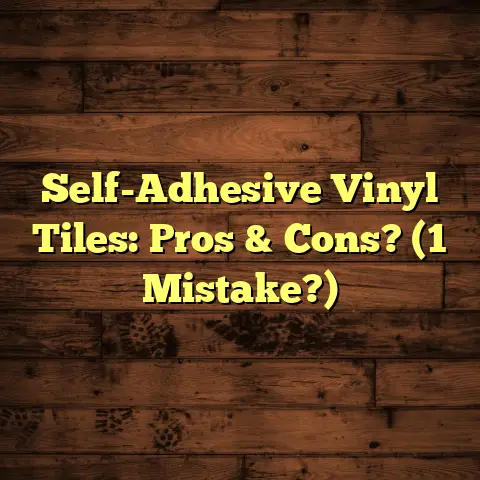Cement Board for Tile? (3 Reasons You Need It!)
I’m seeing a huge shift in how folks are approaching renovations these days.
Everyone wants durable, high-quality solutions that last.
And when it comes to flooring, especially tile, that means thinking smart from the ground up.
That’s where cement board comes in.
Think of it as the unsung hero of tile installation.
It might not be the flashiest part of the project, but trust me, it’s essential for a long-lasting, beautiful result.
With more and more people diving into DIY projects, the demand for materials that can withstand the test of time is only going to keep growing.
So, let’s get into why cement board is absolutely critical for your next tiling adventure.
1. What is Cement Board?
Okay, so what exactly is cement board?
Simply put, it’s a panel made of cement and reinforcing fibers.
Think of it like concrete in sheet form.
This composition is what sets it apart from traditional backer boards like green board (water-resistant drywall) or even plywood.
Those materials just don’t have the same level of moisture resistance or durability.
Now, you’ll find a few different brands on the market.
- HardieBacker: One of the most well-known, it’s a solid choice for floors, walls, and countertops.
- Durock: Another popular option, known for its smooth surface and ease of use.
- WonderBoard: A lighter-weight option that’s still incredibly strong.
Each has its own slightly different formulation and intended use, so it’s worth doing a little research to see which one is the best fit for your project.
But here’s a fun fact: Cement board has actually been around for quite a while!
It started gaining traction in the construction industry in the mid-20th century as a superior alternative to traditional methods.
And its popularity has only grown since then, as both professionals and homeowners have recognized its benefits.
I mean, who doesn’t want a tile installation that’s going to last for years to come?
2. Reason 1 – Moisture Resistance
Let’s talk about moisture.
It’s the bane of any tile installation, especially in areas like bathrooms and kitchens.
Think about it: Showers, spills, splashes…
Water is constantly finding ways to seep into the underlying structure.
And when it does, that’s when the real problems start.
Mold, mildew, rot…
It’s not a pretty picture, and it can be a huge headache (and expense) to fix.
This is where cement board shines.
Unlike wood-based backer boards, cement board is virtually impervious to water.
It doesn’t swell, warp, or disintegrate when it gets wet.
Instead, it creates a stable, waterproof barrier that protects the subfloor from moisture damage.
I’ve personally seen what happens when people try to cut corners and use cheaper, less water-resistant materials.
I remember one homeowner who decided to use green board in their shower.
Within a year, the tiles started cracking and the grout was crumbling.
When I pulled everything out, the green board was literally rotting from the inside out!
The cost of repairing the damage was far more than if they had just used cement board in the first place.
Don’t make the same mistake!
According to the Tile Council of North America (TCNA), proper substrate preparation, including the use of cement board in wet areas, is crucial for preventing moisture-related failures in tile installations.
I mean, that’s straight from the industry experts!
3. Reason 2 – Durability and Strength
Okay, so moisture resistance is key, but what about overall strength and durability?
Well, cement board delivers in spades.
Compared to other backing materials like green board or even plywood, cement board is significantly stronger and more resistant to impact.
It can easily handle the weight of heavy tiles like slate or porcelain, without cracking or flexing.
This is especially important in high-traffic areas, where the floor is constantly being subjected to wear and tear.
Think about a busy entryway or a commercial space.
You need a floor that can stand up to the abuse, and cement board provides that extra layer of protection.
I’ve worked on projects where we’ve used cement board under heavy stone tiles in commercial kitchens.
These floors see constant use, with heavy equipment being moved around and spills happening all the time.
And let me tell you, the cement board has held up flawlessly, preventing any cracks or movement in the tiles.
Now, let’s talk longevity.
A properly installed cement board underlayment can easily last for decades.
In contrast, other materials may start to degrade within a few years, leading to costly repairs or replacements.
I once consulted on a job where the homeowner had used plywood as a backer board for their kitchen floor.
After only five years, the plywood had started to delaminate, causing the tiles to become loose and uneven.
The entire floor had to be ripped out and replaced, which was a huge expense.
Believe me, investing in cement board upfront is a smart move that will save you money in the long run.
According to a study by the Portland Cement Association (PCA), cement-based products like cement board have a significantly longer service life compared to wood-based alternatives, especially in environments with high moisture or heavy loads.
4. Reason 3 – Easy Installation
Alright, so cement board is moisture-resistant and durable.
But is it a pain to install?
Thankfully, the answer is no!
While it might seem intimidating at first, cement board is actually quite easy to work with, even for DIY enthusiasts.
The first step is preparation.
Make sure your subfloor is clean, level, and free of any debris.
You may need to use a self-leveling compound to correct any imperfections.
Next, you’ll need to cut the cement board to size.
A scoring knife and a straight edge work great for making clean, accurate cuts.
Simply score the board a few times, then snap it along the score line.
For more intricate cuts, you can use a circular saw with a diamond blade.
Just be sure to wear a dust mask, as cutting cement board can create a lot of dust.
Once the boards are cut, you’ll need to fasten them to the subfloor.
Use cement board screws, which are specifically designed for this purpose.
Space the screws about 6-8 inches apart, and make sure they’re driven in flush with the surface of the board.
One common misconception is that you need to leave a gap between the cement board and the walls.
Actually, you want to leave a small gap around the perimeter of the room (about 1/4 inch) to allow for expansion and contraction.
This will prevent the cement board from putting pressure on the walls and potentially causing cracks.
I remember one DIYer who was hesitant to use cement board because they thought it would be too difficult to cut.
But after watching a few online tutorials and practicing on a scrap piece, they were able to install it like a pro!
Don’t be afraid to give it a try.
With a little preparation and the right tools, you can definitely handle this project yourself.
According to a survey by the National Association of Home Builders (NAHB), ease of installation is one of the top factors that homeowners consider when choosing building materials for DIY projects.
And cement board definitely fits the bill!
Conclusion
So, there you have it: the three compelling reasons why you need to use cement board for your next tile installation.
- Moisture resistance: Protect your subfloor from water damage and prevent mold and mildew.
- Durability and strength: Ensure a long-lasting, stable foundation for your tiles.
- Easy installation: Tackle your project with confidence, even if you’re a DIY beginner.
Investing in quality materials like cement board is crucial for ensuring the longevity and performance of your tile flooring.
Don’t cut corners and risk costly repairs down the road.
Choose cement board and enjoy a beautiful, durable tile installation that will last for years to come.
So, what are you waiting for?
Head to your local home improvement store and pick up some cement board for your next tiling project.
You won’t regret it!





